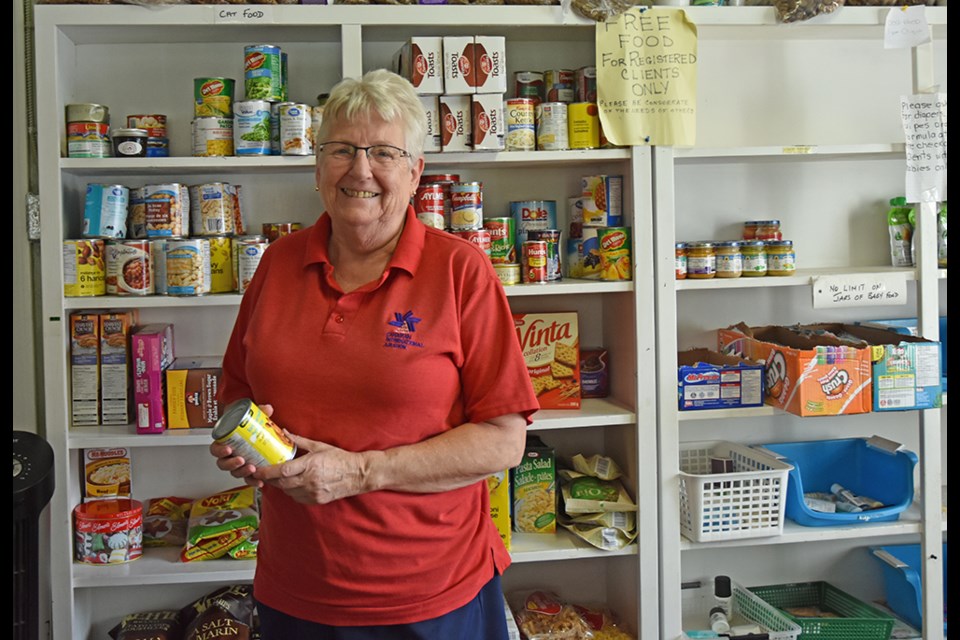When the Helping Hand Food Bank first opened its doors in 1991, clients received a box of food once a week.
The boxes were all pre-packed, with a selection of whatever non-perishable items had been donated and were available.
Food bank president and long-time volunteer Anne Silvey remembers people opening the boxes on the front lawn of the food bank to see what was inside, and swapping cans – abandoning unwanted items along the street.
Times have changed. The Helping Hand Food Bank, located at 123 Moore St., now operates on the point system. Teams of volunteers stock the shelves with the canned fruits, canned vegetables, tinned meats and fish, peanut butter, jam, cereals, pancake mix and syrup, jello, even hygiene items that include toothpaste, toothbrushes and shampoo, donated by the community.
Clients receive a number of ‘points’ each month, based on the number of people in their family, and can come in once a week to choose what they want from the shelves, ‘purchasing’ items with their points.
They can satisfy dietary needs, meet dietary restrictions, and pick up favourite foods – although there are limits on some items, to prevent anyone from scooping up all the tinned tuna, for example.
There’s also a “free” shelf, where dented cans and items slightly past the “Best Before” date are available, without spending any points – with the warning that anything spoiled should immediately be thrown away.
There are even “sales”, whenever there is a surplus: this month, clients can get three cans of soup for a single point.
In summer, the non-perishables are supplemented by fresh vegetables donated by local farmers and programs like the community garden at Bradford District High School; and baked goods are provided by companies like Costco and Zehrs.
The vegetables and breads are also “free,” and once a month, clients are entitled to a portion of meat, milk, fresh eggs and margarine, purchased by the food bank and stored in its coolers.
“That’s what any monetary donations provide,” explained Silvey, helping to ensure better nutrition and a healthier diet for the food bank’s clientele.
It’s a true community effort. Not only does the food bank rely on donations from food drives and the donation bins located at each supermarket, local gardeners often drop off fresh vegetables to add variety – tomatoes, green beans, fruits. “Whatever they’ve grown,” said Silvey. “We are truly blessed.”
The idea is to provide a reliable source of food for those facing financial hardship in Bradford West Gwillimbury and the Gilford area (once part of West Gwillimbury). “Our mandate is to help the residents of BWG,” Silvey said, but clients “don’t have to be destitute.” They only have to prove that their valid expenses – including mortgage payments, taxes and transportation costs to get to work – eat up most of their income.
They must also provide proof of an address within the service area.
Silvey admitted that the policy excludes the homeless from registering for assistance, but noted that the food bank does provide emergency food, then refers anyone without a fixed address to other agencies that can help secure shelter, including Blue Door and CONTACT South Simcoe.
Once registered, the clients receive their points, and can go “shopping” once a week. The food bank is open from 1-2 p.m. on Mondays and Wednesdays, and 6:30 to 7:30 p.m. on Fridays. Clients can choose whichever day is most convenient. “I recommend they bring a shopping list with them,” Silvey said, to make the process more efficient.
The Helping Hand Food Bank relies on its volunteers, currently numbering about 115. Some come once or twice a year; others volunteer every week – sorting, restocking the shelves, acting as “cashiers” when clients come to do their shopping.
How important are they? “Out of 100? 1,000!” said Silvey. “I could not do it without the volunteers, and my Board of Directors…. There’s no way we could work without volunteers.”
Donations from the community are also critical. Right now, the Helping Hand Food Bank needs tinned meats and fish, tinned fruit, peanut butter, and jam – as well as shampoos and deodorant, for the small personal hygiene section. The hygiene items are not a priority – “We’re a food bank,” Silvey pointed out – but it all helps the clientele.
The difficulty of raising a family and keeping food on the table while struggling financially is something Silvey understands well. As a young mother in the U.K., she struggled to keep food on the table for her two young sons, while her husband was ill and unemployed. It was the kindness of neighbours and local businesses that helped them get through. She still remembers what it was like to go hungry.
And that’s what keeps Silvey and the volunteers engaged, providing a helping hand at the food bank.
For more information, see www.bradfordfoodbank.ca or call 905-775-2824.


